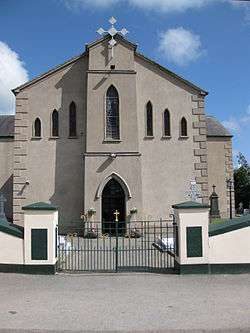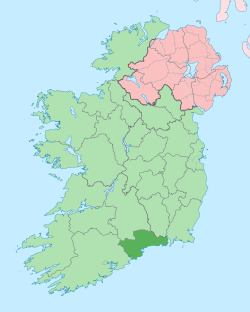Kilrossanty
Kilrossanty (Irish: Cill Rosanta)[1] is a small village and parish in County Waterford, Ireland.[2] It lies between the Comeragh Mountains and the R676 road between Dungarvan and Carrick-on-Suir, close to the Mahon Falls.
Kilrossanty Irish: Cill Rosanta | |
|---|---|
Village | |
 St Brigids church | |
 Kilrossanty Location in Ireland | |
| Coordinates: 52°10′38″N 7°32′46″W | |
| Country | |
| Province | Munster |
| County | Waterford |
| Time zone | UTC+0 (WET) |
| • Summer (DST) | UTC-1 (IST (WEST)) |
Amenities
Local leisure facilities include Kilrossanty GAA sports club, a pub in the village, and hillwalking in the Comeragh mountains.
Religion
Beside the ruins of the old village church are three holy wells, the main one dedicated to St. Brigid.[3]
Buildings
Comeragh House, a landed mansion outside the village, was the home of 19th-century explorer John Palliser,[4] and between 1964 and 1979 was lived in by Dutch art collector Pieter Menten, until he was arrested in the Netherlands and convicted of being a World War 2 war criminal. On his release from prison in 1985, he planned to return to Comeragh House, but was banned by the government from entering Ireland. The house was sold two years later following Menten's death.[5][6]
External links
References
- "Placenames Database of Ireland". Dublin City University. Retrieved 7 January 2015.
- "Kilrossanty". A Topographical Dictionary of Ireland. Library Ireland. 1837. Retrieved 2014-04-12.
- "Kilrossanty Holy Wells". Megalithic Ireland. Retrieved 2014-04-12.
- Eoin Butler (2017-01-21). "The Irishman who gave his name to a mountain range in the Rockies". Irish Times. Retrieved 2017-01-23.
- "Millionaire Nazi War Criminal Leaves Prison". Los Angeles Times. 1985-03-22. Retrieved 2014-04-12.
- Michael Lavery (2011-04-22). "Nazi criminal mansion goes on sale at €3m". Evening Herald. Retrieved 2014-04-12.
